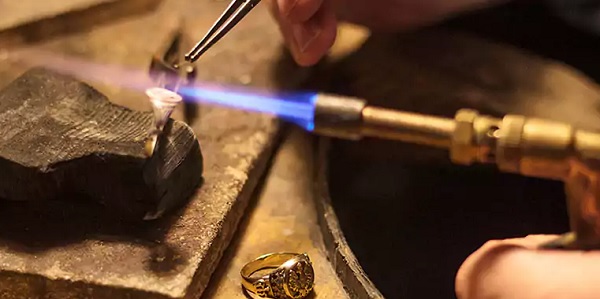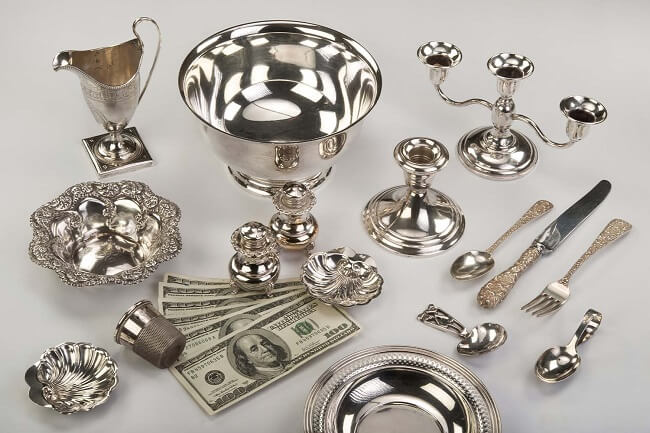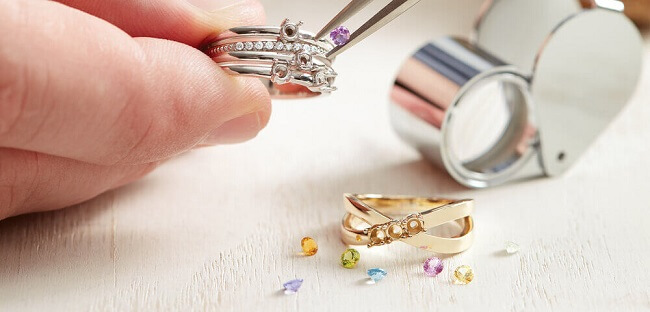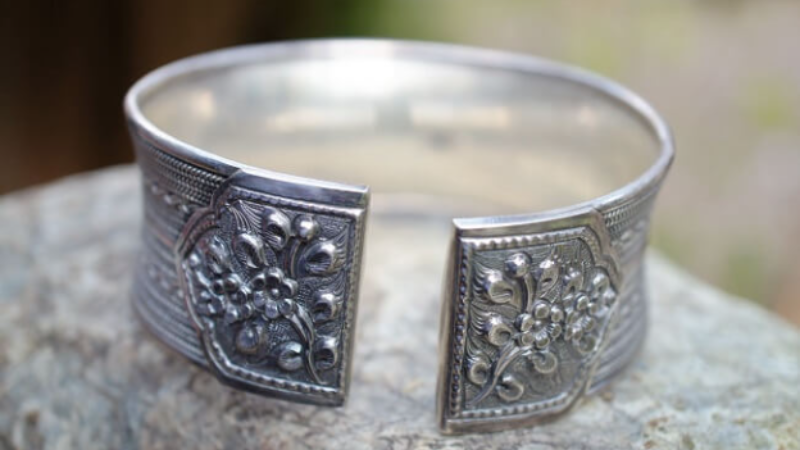
Are you a new jewelry fabrication enthusiast or a metal art lover? If so, you must be keen to know more about the comparison of Stainless Steel vs. Sterling Silver. This is because of their similar or close appearances which can be confusing to many.
In this post, we provide you with a comprehensive comparison and contrast between these two competing jewelry giants to help you decide on the best option.
Before we dive deeper, let’s begin by exploring their description differences.
Stainless Steel & Sterling Silver – Definitions.
Understanding Stainless Steel
Stainless Steel is a popular alloy known for its durability and high resistance to corrosion. Its constituent metals are mainly iron, carbon, and chromium.
It may also contain additional metals such as nickel, titanium, and manganese among others.
There are many Stainless Steel grades you can choose from based on your requirements. Their applications range from the construction and architectural parts manufacturing, jewelry industry, and medical instruments manufacturing industry among others.
Some of the unique characteristics of Stainless steel that will warm your “metal heart” are its strength, durability, resistance to heat, and corrosion resistance.
Next… its closest competitor, Sterling Silver
Understanding Sterling Silver
Sterling Silver is a valuable and stunning metal alloy that constitutes 92.5% silver and 7.5% other metals with copper being the most popular option.
You will appreciate that this combination gives Sterling Silver its unique glow of beauty.
The elegant appearance, coupled with its strength, has made it popular for centuries, especially in the manufacture of jewelry, flatware, and hollowware. It is also used in the metal art industry.
Stainless Steel vs. Sterling Silver – Key Differences

Now that you know the main components that form these two confusing alloys, let’s explore more about their other differences. These are critical in helping you make an informed selection decision.
Cost Differences
When shopping for your wide range of jewelry, you will notice that Sterling Silver jewelry or any other metal item costs more compared to Stainless Steel equivalent. Why?
Silver, which forms the largest part of Sterling Silver is a rare metal. Therefore, this makes Sterling Silver more precious and expensive than Stainless Steel.
Further, the manufacturing process of Sterling Silver is more demanding in terms of labor requirements than Stainless steel.
Difference In Corrosion Resistance
When comparing their corrosion resistance, stainless steel wins the battle. This is because of its unique combination of iron, chromium, and other alloys that are highly resistant to both corrosion and oxidation threats.
Magnetic Properties
The elements in Stainless Steel and especially iron make its metal parts cheerfully magnetic! This is unlike Sterling Silver which does not dance to magnetic drum beats!
Strength and Durability
If you are keen on a stronger and more durable beauty accessory or metal item, then Stainless steel is your best choice.
So, it is the superior strength of Stainless steel that gives it a more respectable position when it comes to construction and other industrial applications.
Maintenance Requirements
While Sterling silver can instantly melt your heart and soul with its lustrous shine and glow, it is more prone to tarnishing than Stainless Steel.
So, to maintain its shine and beauty, you need to clean and polish it regularly.
Thermal and Electrical Conductivity
While Stainless Steel and Sterling silver are good electrical and thermal conductors, Stainless Steel emerges as your clear winner in this battle.
Appearance/Color/Shine and Luster
You may find it difficult to tell the difference between Sterling Silver and Stainless Steel. However, when you take a closer look, you will notice that Sterling Silver is more elegant because of its softer and lustrous silver shine.
Stainless steel does not have the same luster as Sterling Silver. It appears grey in hue with lesser surface shine or reflection.
Differences in Identification Numbers or Stamps
You must have noticed genuine Sterling Silver jewelry pieces such as rings have the number 925 stamped on their surfaces. This is to indicate that their silver composition is 92.5%
For Stainless Steel, three-digit numbers may or may not be stamped on the alloy surface. Such examples are Stainless steel 304 or 316. The numbers indicate the quality level of your stainless steel.
Stainless Steel vs. Sterling Silver – Advantages and Disadvantages
Advantages of Stainless Steel
Here are some of the advantages you will derive from stainless steel:
Less Costly
Manufacturing Stainless steel is generally less expensive if you compare it with Sterling silver items.
Therefore, if you are budget-conscious, it is a better option than Sterling Silver.
The low cost of Stainless Steel is a result of the low cost of raw materials. Its manufacturing process is also not as demanding as the case with Sterling Silver.
Stainless steel vs sterling silver price, Because of its low cost, reselling your stainless steel item means your resale price will be much lower.
Highly Durable
Stainless Steel is highly resistant to corrosion. This makes it one of the most durable metals you will often come across.
Due to its durability, it is used in a wide range of industrial applications including in the manufacture of lasting jewelry.
Application Versatility
The strength and the malleability of Stainless Steel make its application more versatile than you can experience with Sterling Silver.
Non-toxic
If you are looking for a non-toxic metal suitable for food and medical applications, or that will not harm your skin when used as jewelry, then Stainless steel is the material to go
Further, if you are prone to allergies, high-quality Stainless Steel jewelry is perfect for you.
Low Maintenance Cost
If Stainless steel is your metal item or jewelry choice, you don’t have to worry about its maintenance. This is because it is tarnish-resistant. No need for frequent cleaning or polishing as is the case with Sterling Silver items.
Disadvantages of Stainless Steel
Hard Surface – Surface finishing challenge
Shaping Stainless Steel material and finishing its surface as you would desire is more difficult. This is because it is a harder material compared to Sterling Silver.
You have to use special tools to achieve your required finishing because it is not as easy to polish as Sterling Silver.
Not Resistant to Impacts
Despite its hardness, your stainless steel metal is not as resistant to impacts as Sterling Silver. So, it can easily bend when subjected to impacts.
Can be Corroded in Extreme Conditions
While Stainless steel is corrosion resistant, it can not withstand extreme conditions as Sterling silver.
Therefore, if your stainless steel jewelry or metal material is exposed to high humidity and other harsh elements, it will begin to corrode.
Non-favorable Magnetic Property
Unlike Sterling Silver which is not magnetic, Stainless steel materials can be easily affected by magnetic fields as they have magnetic properties.
You may not find this suitable for certain application areas.
Less Malleable
Because of its hardness, Stainless steel is not as malleable as Sterling Silver. So, you cannot easily manipulate it into different intricate shapes especially if you are in the jewelry or metal art industry.
It Is Heavy
Stainless steel vs sterling silver weight, In terms of weight, Stainless Steel is much heavier compared to Sterling Silver which may not be desirable or convenient for some of your application areas.
Low Melting Point
The melting point of Stainless Steel is lower than Sterling Silver. So, when soldering your SS piece or exposing it to heat, you have to be extra careful because it can easily get deformed.
Allergy Risks
Low-quality Stainless Steel jewelery may have a nickel composition. Nickel is known to cause allergic reactions in some people. So, if you have a sensitive skin, you may experience skin irritations
The good news is that the majority of people are not at risk of such exposure. This is because the percentage of those with sensitive skin is pretty low.
Advantages of Sterling Silver
Here are some of the key advantages of Sterling :
Durability
If you are looking for a durable metal piece for your jewelry or artwork that is resistant to scratch and corrosion, then Sterling Silver will serve you well.
More malleable metal
Reshaping and refining work on Sterling silver is much easier because it is more malleable and excellently resistant to both wear and tear. This makes it a suitable alloy for jewelery pieces.
Lighter In Weight
Sterling silver is lighter than Stainless steel. So, as your jewelry selection, you will find it more comfortable to wear because of less strain on your skin.
Soft and Ductile – Easy to Work With
Sterling Silver material is softer than Stainless steel which makes cutting it much easier especially when you are working on intricate shapes or items such as jewelry or metal artwork.
It is also ductile allowing for easy bending and reshaping to suit your desired design.
More Valuable
Sterling Silver is a rare alloy and is in high demand. Therefore, it is much more valuable compared with Stainless steel.
It means if you adorn Sterling silver jewelry, your taste in high-value fashion will be vivid.
Exudes More Elegance | Has A Unique Touch of Style
At times you just need to step out of the ordinary to the extraordinary when it comes to beauty and elegance.
Sterling silver with its reflective surface offers you a more elegant and classy look that Stainless steel cannot match. It adds a unique touch of trendy fashion to your style.
Superior Luster and Shine of Beauty
Sterling silver will grab your attention with its surface shine and luster. It is a must-collection if you are a true beauty accessories enthusiast or metal art lover.
With its enhanced reflectivity and ability to absorb light, it exudes a glowing shine of beauty that Sterling Steel can only envy!
Versatility In Application
With Sterling Silver as your metal piece, you can create a wide variety of jewelry designs or items. This is mainly because it is more malleable.
The products you can create from Sterling Silver can range from, utensils, jewelry, metal art, and other home decor items.
Further, Sterling Silver comes in different colors and finishes to suit your taste of style.
The versatility in its application is because it is more malleable compared to Stainless steel.
Good Thermal and Electrical Conductivity
Sterling silver is a great conductor of heat and electricity. This makes it suitable in application areas that require a good electrical connection.
Affordable
Though more expensive than Stainless Steel, Sterling silver is a relatively affordable metal compared to some other precious metal items such as gold or platinum. This makes it a great option if you are on a budget
Hypoallergenic for Comfortable Wearing Experience
By choosing the high-quality 925 Sterling Silver as your jewelry or item piece, you easily avoid possible allergic skin reactions for ultimate comfort.
It is important to note that though silver does not cause allergic reactions, it is the composition of other metals, especially nickel that causes skin irritation but only in some people.
Disadvantages | Drawbacks of Sterling Silver
More Expensive and Hard To Manufacture
Sterling Silver products are not pocket-friendly when compared with Stainless Steel. Therefore, getting a Sterling Silver item or jewelry will cost you much more compared to its equivalent Stainless Steel option.
Not Resistant to Tarnish
Stainless steel vs sterling silver tarnish, Your favorite Sterling Silver metal pieces or jewelry will easily get tarnished when exposed to harmful elements after some time. It is not tarnish-resistant as Stainless steel.
Therefore, to your Sterling Silver items in their perfect and attractive condition, you must regularly clean or polish them.
Less Stronger
If not handled carefully, your Sterling Silver items can break easily when subjected to bending force. This is because they are not as strong as Stainless steel.
So, if you have small and intricate Sterling Silver jewelry or other items, you have to handle them carefully to avoid possible breakages.
Not Resistant to Heat.
High temperatures or exposure to extreme heat can easily damage your valuable Sterling Silver items.
Because it has a low melting point, your items can get deformed, damaged, or simply melt when subjected to extreme temperatures.
Not Magnetic
If you desire a metal piece or jewelry with magnetic properties, then Sterling Silver will not be your best choice. Unlike Stainless steel, sterling silver is not magnetic.
Needs Regular Maintenance
To maintain the glow and authentic shine of your Sterling Silver item or jewelry, regular maintenance is necessary.
Because it is not tarnish-resistant as Stainless Steel, you have to frequently clean and polish your Sterling Silver items.
Limited Resistance to Rust and Oxidation | Less Resistant to Weather
The resistance of Sterling Silver against rust and oxidation is lower compared to Stainless steel.
If your Sterling Silver item is exposed to moisture, air, and other harsh weather elements such as extreme temperatures and humidity, it will gradually rust and easily get damaged.
Soft and Delicate – Not Scratch or Dent-Resistant
Sterling Silver, as with other precious metals such as gold and platinum, is softer and more delicate than stainless steel.
So, you have to be more careful about how you handle it to avoid surface damage such as scratches or dents.
Stainless Steel vs. Sterling Silver – Industry Applications
Cutlery Items & Appliances – Flatwares and Hallowares

You can use Stainless Steel material to create or manufacture cutlery and a wide range of kitchen appliances.
Some of the highly durable Stainless steel flatware and hollowware include spoons, forks, knives, vessels, and candlesticks among others.
These items are easy to clean and highly resistant to both rust and corrosion.
Sterling Silver is also used in manufacturing cutlery products or appliances. However, most flatware or hollowware made from Sterling Silver are meant to captivate with their classic decor designs and beauty and are usually only for some applications.
They are generally more elegant and expensive than stainless steel items. However, they require more maintenance to keep their surfaces beautifully shiny.
Stainless Steel vs. Sterling Silver Jewelry

Stainless Steel and Sterling Silver are popular in the manufacture of your wide range of beauty accessories to suit your style and different occasions.
Stainless Steel jewelry
Stainless steel is a popular choice if you are looking for strong and durable jewelery for your everyday wear.
With its low cost and excellent resistance to rust and corrosion, you can get Stainless Steel accessories in large pieces with no budget constraints.
Its resistance to tarnishing makes it a suitable jewelry material for everyday wear or general occasions.
Some of the Stainless steel beauty accessories you can purchase from reputable jewelry stores include rings, bracelets, and earrings among others.
The two main jewelry grades you can choose from are Stainless 304 and 316.
Grade 316 has additional molybdenum which makes it superior in terms of corrosion resistance. You, however, have to pay more for this premium jewelry grade.
Sterling Silver Jewelry
For the ultimate fashion statement, Sterling Silver deserves to be on the front seats of your beauty accessories box!
Jewelry pieces made of Sterling Silver will strike you with their elegance, vivid shine, and reflective surfaces.
The standard high-quality Sterling Silver consists of 92.5% silver. The remaining 7.5% commonly comprises of copper.
However, to reduce tarnishing, other elements can be used with copper constituting a larger percentage of the 7.5%.
Such additional or enhancement alloys may include zinc, silicon, and boron among others.
Additional metals help in enhancing the piece’s hardness, durability, tarnish resistance, and color appearance to suit your style.
Other cheaper and low-grade Sterling Silver may have a tress of nickel for improved strength. However, nickel is known to cause allergic skin irritations but only in some people.
Being expensive, you will find Sterling Silver used to produce small and intricate jewelry pieces such as rings, and necklaces.
It is used with different types of gemstones and to enhance their wearability and durability, they are available in different finishes to suit your style and preference.
Because Sterling silver tarnishes much faster than Stainless steel, you must keep cleaning and polishing your pieces to maintain their timeless classic beauty.
Stainless Steel Surgical Instruments vs. Sterling Silver

Surgical stainless steel vs sterling silver, You will find many surgical instruments made from high-quality stainless steel because of the metal’s superior strength, durability, and resistance to both rust and corrosion.
However, because of the high cost of Sterling Silver and its low resistance to tarnishing, it is never used to make surgical instruments or equipment. This makes Stainless steel a clear winner in this sector.
Stainless Steel vs. Sterling Silver – Metal Artworks

Stainless Steel In Artwork.
If you are an art lover, then you must have seen a wide range of sculptured artworks done using metal materials.
Stainless steel is commonly used for such artwork due to its strength, corrosion resistance, and durability. Maintaining an art piece made of Stainless Steel will not cost you much because it is tarnish-resistant.
Sterling Silver in Artwork Collections
Sterling Silver is used for valuable art collections such as sculptures. Its popularity is because of its durability and classic elegant look.
Artworks made from Sterling Silver are, however, more expensive compared to Stainless steel. They also require that you undertake regular cleaning and polishing as they are less resistant to tarnishing than Stainless steel.
Stainless Steel vs. Sterling Silver – Which Is Your Better Option?
Your choice of either Stainless Steel or Sterling Silver has both benefits and drawbacks. So, the selection of the best option entirely depends on what you are looking for and your budget.
If you are searching for a cost-effective material that will serve you much longer but with desirable aesthetic charm with less shine, Stainless Steel will be your better option.
However, if you want a more pricy but captivating metal item that exudes a shine of beauty, but requires frequent maintenance, Sterling Silver is your winning choice.
Better still, where applicable, you can have different combinations of these two competing alloy items to balance your preferences effectively.
It is, however, important that when sourcing authentic Stainless Steel or Sterling Silver materials, or items, you only deal with reputable suppliers.
This is because when not careful, you can easily be misled into purchasing the wrong or fake metal.
Alternatively, if you are not sure about your choices, let a trusted expert guide you in making the right purchase decision.
Other Relevant Links
- How To Know If Your Metal Piece is Sterling Silver or Fake
- How to Clean Sterling Silver and Keep It Shiny
- A Comparison Between Red Brass vs. Yellow Brass
- Ultimate Guide to Bronze Fabrication
- The Ultimate Guide – Metal Surface Treatments
- The Complete Guide on Metal Screen Printing
More Resources:
Stainless steel vs sterling silver gold plated
Stainless steel vs sterling silver flatware
Stainless steel vs sterling silver vs titanium
Stainless steel vs sterling silver vs silver
Stainless steel vs sterling silver allergy
Stainless steel vs sterling silver earrings
Stainless steel vs sterling silver for sensitive ears
Solid stainless steel vs sterling silver
Polished stainless steel vs sterling silver
316l stainless steel vs sterling silver




